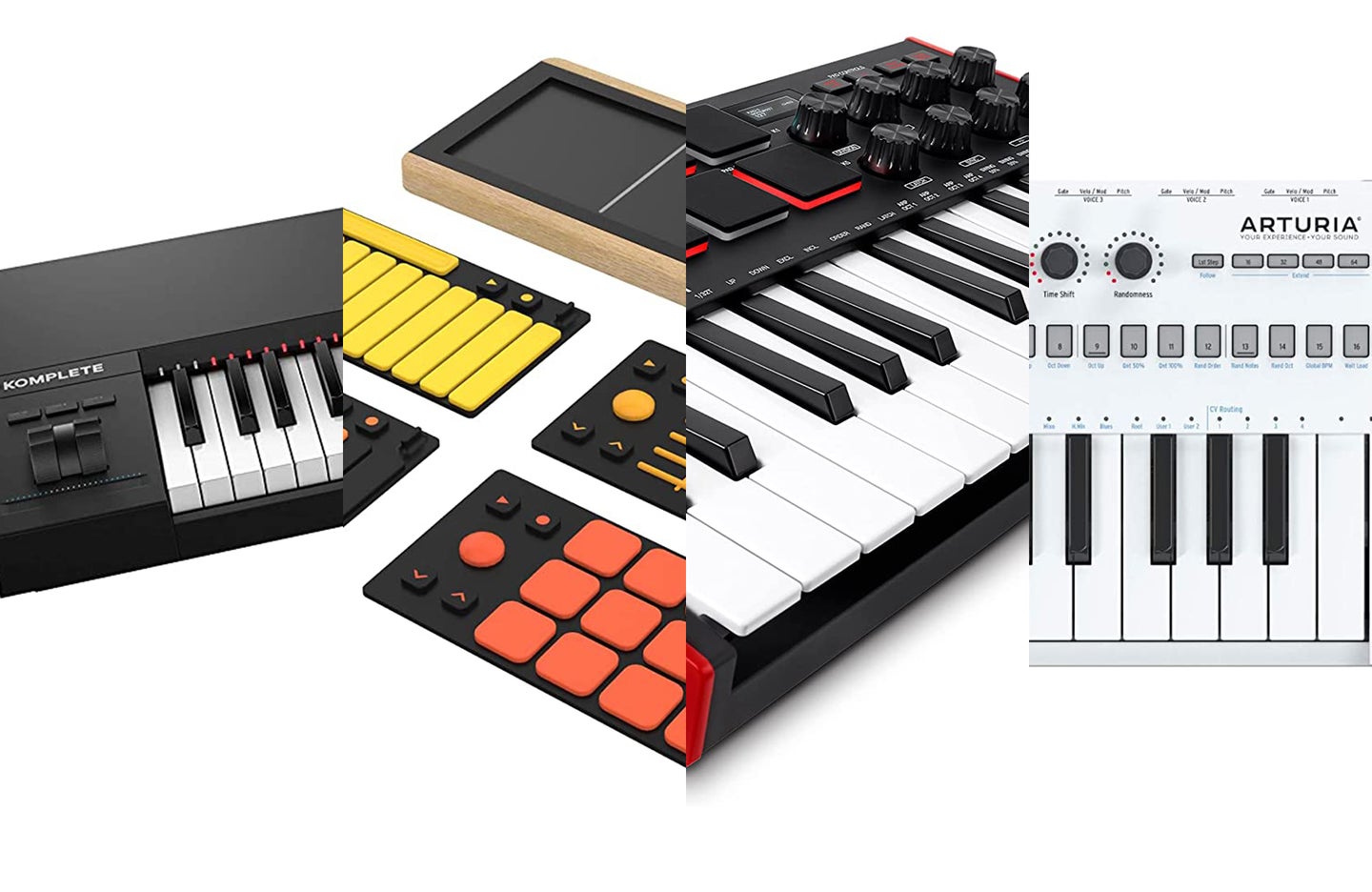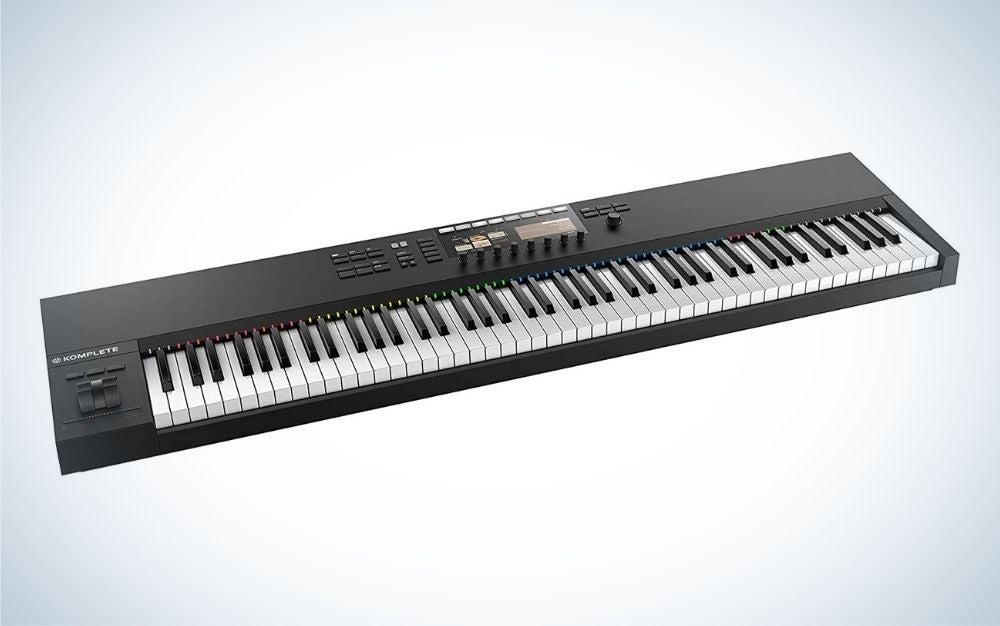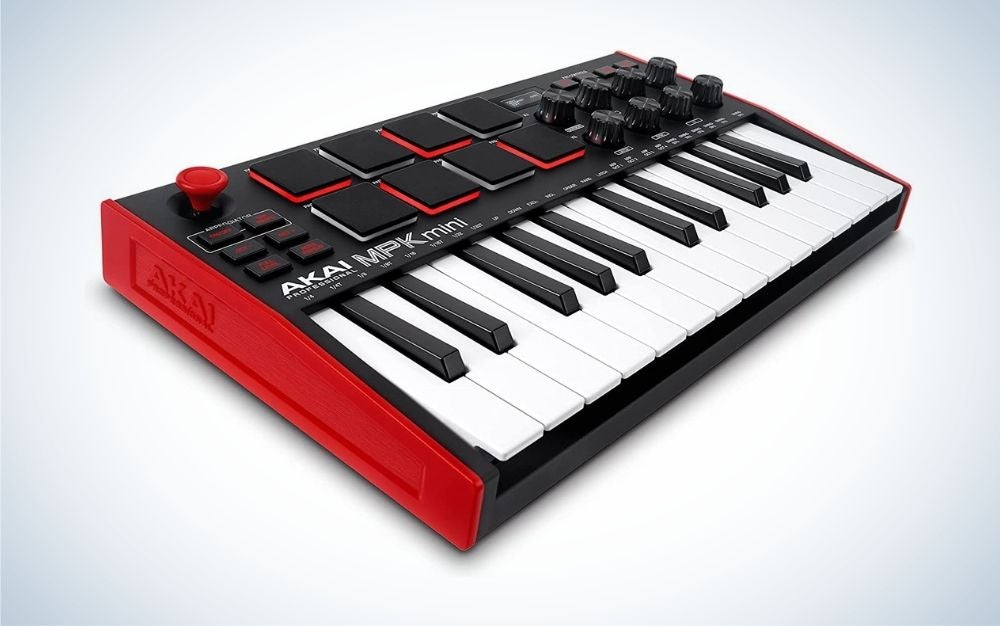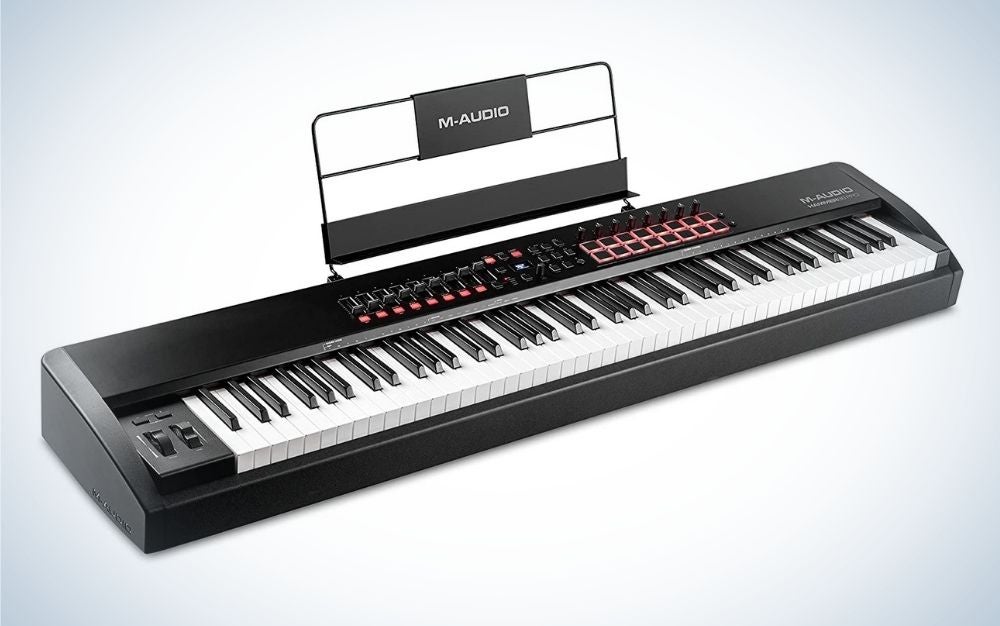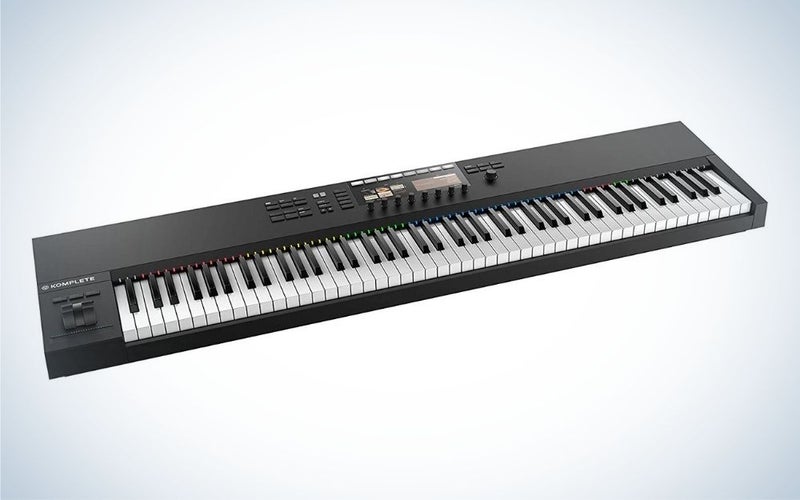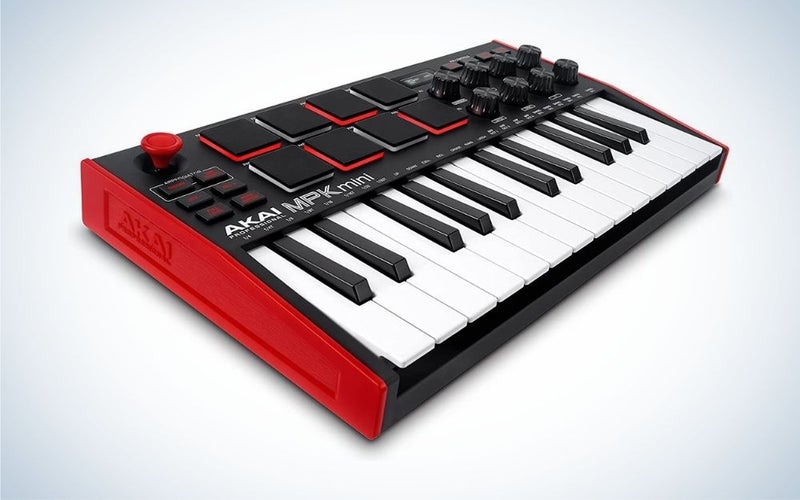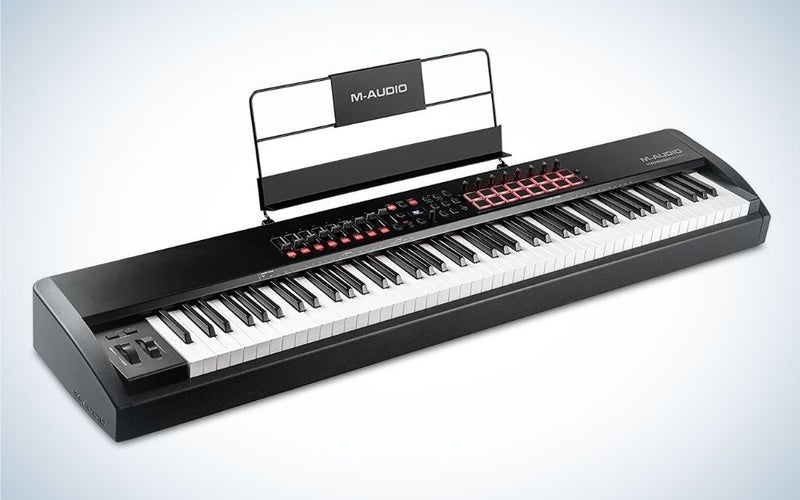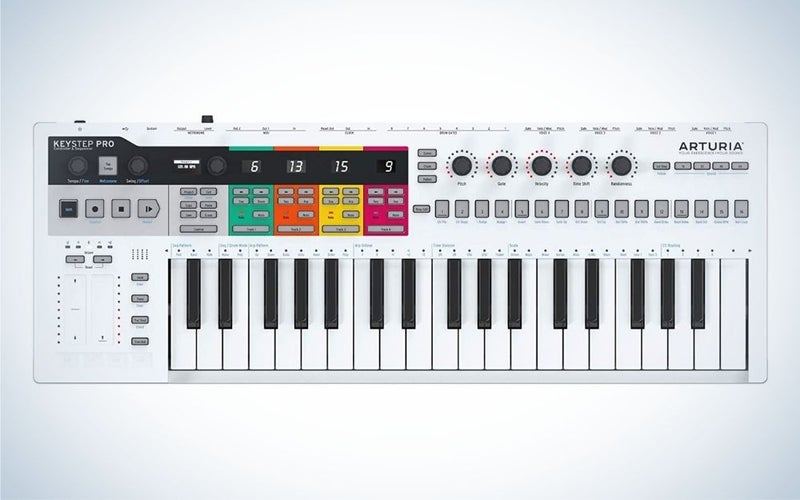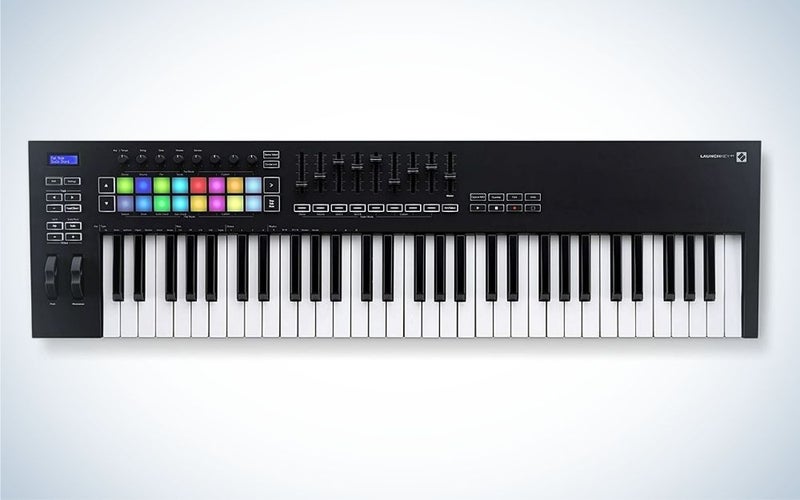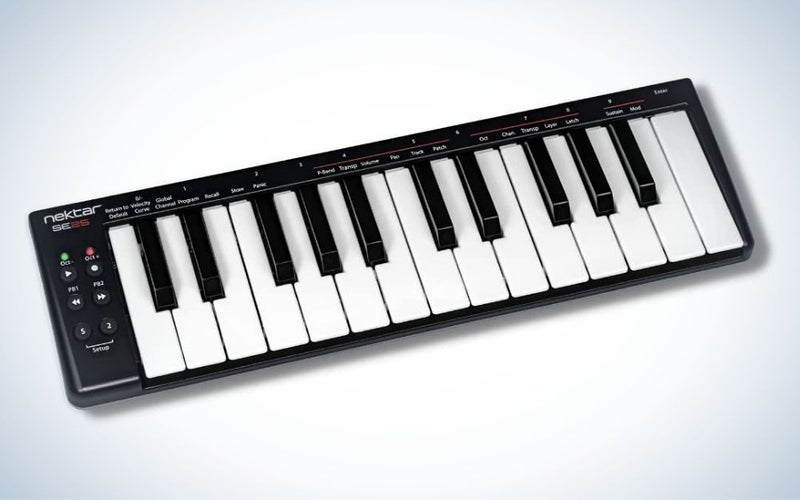We may earn revenue from the products available on this page and participate in affiliate programs. Learn more ›
It’s never been easier (or cheaper!) to make music, thanks to computers and affordable MIDI keyboards. Until recently, even the most basic of home studios seemingly required an advanced degree in electronics to understand how to hook everything up—to say nothing of the cost. Nowadays, you have access to incredibly powerful, surprisingly intuitive music-making software and hardware. And at the center of it all should be one of the best MIDI keyboards.
The right keyboard lets you input all those notes and chords that will set the world on fire. Don’t start popping corks yet, though, as you still need to choose the kind of MIDI keyboard that’s best for you. It’s a little more complicated than just getting any old thing with piano keys and plugging it into your computer. The world of MIDI controller keyboards is broad, with more variables than a badly planned high school science fair project. How many keys do you need? What kind of connectivity is best for you? How much money do you have to spend? You’ll need to consider all of these (and more) before you can start collecting royalty checks from all your future hits. Here are our picks.
- Best overall: Native Instruments Komplete Kontrol S88
- Best for beginners: Akai Pro MPK mini mk3
- Best weighted keyboard: M-Audio Hammer 88
- Best small keyboard: Arturia KeyStep Pro
- Best for Ableton: Novation Launchkey MK III 61
- Best budget: Nektar SE25
How we chose the best MIDI keyboards
There is a bewildering number of MIDI keyboards on the market, with options that range in key number, size, and weight to ones offering more esoteric extras, like CV/gate connectivity for interfacing with modular synthesizers. Some are for general use, while others have been designed to work best with specific digital audio workstations (DAWs) and music production software. What all of them offer, however, is compatibility with MIDI, or Musical Instrument Digital Interface—an industry-standard connection/communications protocol that converts interactions with the keyboard into instructions for compatible interfaces, computers, musical instruments, and other outboard processors/sound modules.
We looked at all of these options when hammering out our list of the best MIDI keyboards. To narrow down our top controllers for each category, we made use of our own experience as experts in the field—specifically, I’ve spent three decades as both a professional musician and writer for top music technology publications, including Attack Magazine, Computer Music, MusicTech, Reverb.com, IGN.com, and more. In addition, we drew on the opinions of our peers and factored in critical consensus, user impressions, as well as the use cases of famous music producers and composers.
The best MIDI keyboards: Reviews & Recommendations
Because MIDI keyboards don’t make any sound themselves, it can be tempting to scrimp on one and put that money toward something else in the studio (maybe you’re eyeing a new laptop or a fine new monitor to make your session look as sweet as it sounds). But when you consider that your MIDI keyboard will likely sit at the center of your studio monitors or live rig and that you’re going to be putting your hands on it more than any other piece of gear you own, you start to see why investment is worth it. So, as the price often will determine not only quality but the number of options, it can be helpful to start with a budget and then work from there, with any additional necessities like knobs and sliders following suit. No matter your budget, though, you can be confident that all of the keyboards on this list are worthy of your hard-earned cash.
Best overall: Native Instruments Komplete Kontrol S88
Native Instruments
Why it made the cut: A full keybed plus smart DAW and computer integration means you’ll finally take your eyes away from the computer and focus on the music.
Specs
- Keys: 88 full-size weighted keys
- Connectivity: USB 2.0, MIDI in/out, 2 pedal controller inputs
- Compatibility: Mac/PC
Pros
- Fully weighted hammer-action keys
- Two high-res color displays
- DAW integration
Cons
- No sliders or drum pads
- Best with Native Instruments Komplete software
Modern music production is all about the DAW, or the digital audio workstation. Because of this, we tend to keep our eyes trained on the computer monitor, for better or for worse. German company Native Instruments thinks this is for the worse and so has designed a series of MIDI keyboards that encourage you to look away from the computer and interact more with the keyboard itself. Called Komplete Kontrol, they range from the small to the large, with our pick for best overall MIDI keyboard, the S88, at the top of the line.
As the name suggests, the S88 has 88 keys, with a fully weighted Fatar keybed with hammer action—something that piano players looking for an acoustic piano feel and level of control will surely appreciate. It also has two control pedal inputs to ensure that your playing can be as realistic as it needs to be. To this keybed it adds a row of eight rotary encoders and a slick four-directional push encoder for navigating the two high-res color displays. The latter features are how NI gets your eyeballs off the monitor. With deep DAW integration, this full-size MIDI keyboard can replicate portions of your DAW on the twin screens, allowing you to do tasks like mixing from within the keyboard. It also integrates with software via the included Komplete Kontrol application, which can run standalone or as a DAW plugin. This maps Native Instruments and participating third-party software instantly to the knobs, saving you the trouble of having to create MIDI maps to control things like filter cutoff.
Komplete Kontrol S88 is not cheap, but as a fully featured MIDI controller with a piano-like keyboard, it’s just begging to be the centerpiece of your home studio. For musicians who like the functionality but don’t need all the keys, look to the Komplete Kontrol S49 or Kontrol S61 for the same extras without the extra octaves.
Best for beginners: Akai Pro MPK mini mk3
Akai Professional
Why it made the cut: Keys, pads, knobs, and even a free bundled DAW—what more could a beginner want?
Specs
- Keys: 25 mini keys
- Connectivity: USB 2.0, sustain pedal input
- Compatibility: Mac/PC
Pros
- 8 pads straight from the MPC line
- Lightweight and portable
- Includes free MPC Beats DAW
Cons
- Mini keys could be better
Want to make beats but don’t know where to begin? As long as you have a computer, Akai Pro’s MPK mini mk3 can provide a solid and affordable entry point into the world of music production.
For those not in the know, Akai Pro is the company behind the MPC line of hardware samplers, a series of grooveboxes that laid down the blueprint for hip-hop and other genres of music. What does this have to do with a MIDI keyboard? The MPK mini mk3 (the best-selling MIDI keyboard in the world, according to Akai Pro) borrows some of that MPC hardware magic and pairs it with MPC Beats, the DAW version of the music-making operating system inside the machines. For around $100, you’re making music with the best of them.
Think of the MPK mini mk3 as an all-in-one MIDI controller. It’s got 25 mini keys, eight drum pads taken straight from the MPC with both channel and polyphonic aftertouch for complete timbre control (unheard of at this price point), eight endless encoders for controlling software instrument parameters, a mappable X-Y joystick, an arpeggiator, and even an OLED screen for visual feedback. It’s light enough to take on the go and solid enough to not slip around your studio when you bang out drum beats.
While the action on the keys could be better, for this price you’re getting a lot of controller for not much money. It’s hard to not recommend it more strongly for many, not just as the best beginner MIDI keyboard.
Best weighted keyboard: M-Audio Hammer 88
M-Audio
Why it made the cut: Grand piano action for around $500.
Specs
- Keys: 88 full-size weighted keys
- Connectivity: USB 2.0, MIDI out, 3 pedal ports
- Compatibility: Mac/PC
Pros
- Gorgeous weighted piano feel
- Affordable price
- Music rest
Cons
- Lacks additional controls
There are music producers, and then there are musicians. While those in the former category want all manner of control with their MIDI keyboard, the latter really care about just one thing: the keys. If you’re primarily a keyboardist and your means of expression is your instrument, you want a MIDI keyboard that will provide a piano-like experience. You want M-Audio’s Hammer 88.
A well-made keyboard with a minimal aesthetic, Hammer 88 offers seven octaves of velocity-sensitive and weighted keys. They have a substantial, almost acoustic feel to them and piano players will take to them instantly. Part of the piano experience is using the pedals, so Hammer 88 provides three pedal ports: one each for sustain, soft, and expression. There’s even a music rest included.
While M-Audio’s keyboard doesn’t offer a lot in terms of hands-on control—no arrays of encoders or sliders here—it does make concessions to modern synth players, with pitch and modulation wheels, as well as two basic selection buttons. A bundled application allows users to set up splits and other configurations.
At only around $500, M-Audio’s Hammer 88 is a striking bargain. And, if you really find yourself needing drum pads, M-Audio makes one with additional controls. Players, do seek this one out.
Best small keyboard: Arturia KeyStep Pro
Arturia
Why it made the cut: A plethora of control options elevate this Swiss army knife of a MIDI keyboard.
Specs
- Keys: 37 slim keys
- Connectivity: 4 x CV/gate/modulation output sets, 8 drum gate outputs, 1 MIDI in, 2 MIDI outs, USB, clock synchronization in/out, metronome line out, sustain port
- Compatibility: Mac/PC
Pros
- 4 sequencer lanes
- Analog and digital drum triggering
- DAW control mode
Cons
- White color may turn some off
Most of the MIDI keyboards on this list are designed to work in tandem with computers. Yet there’s a growing movement of musicians breaking away from the screen and going DAWless. This includes modular synthesizer users, for whom experimentation, free from the rigid structure of a computer-based sequencer, is key. If this sounds like you, you need Arturia’s Keystep Pro.
A 37-key controller, the Keystep Pro combines sequencing and MIDI note triggering into one device. It has four sequencer lanes with one doubling as a drum programmer. Sequencing here goes beyond just note on/off, but also includes gate length, note offset, velocity, and more. Think of it as a box of tools to experiment with notes and patterns. The Keysetp Pro can transmit control information via MIDI over USB or five-pin DIN MIDI cable, or through control voltages—the language of modular and vintage synths. Of course, Arturia’s MIDI keyboard can also work with a DAW, with a customizable controller mode for mapping to soft synths and other applications.
Because it does so much, the Keystep Pro is a little pricey for a MIDI keyboard with mini keys. Should you want something similarly unconventional but with a friendlier price tag, Roli’s Lumi Keys and Keith McMillen’s QuNexus Red are inspiring alternatives.
Best for Ableton: Novation Launchkey MK III 61
Novation
Why it made the cut: It’s the most, well, able-bodied controller for everything the Ableton power user needs.
Specs
- Keys: 61 full-size keys
- Connectivity: USB, MIDI out, sustain pedal port
- Compatibility: Mac/PC
Pros
- Effortless Ableton integration
- Plenty of knobs, sliders, and buttons
- Excellent price
Cons
- Non-Ableton users may feel left out
Despite what some may argue, all DAWs are not the same. Sure, they’ll all get you to the same place—a (hopefully) finished song—but the way they transport you there can often be very different. A case in point is Ableton Live. With its two views and focus on clips and live performance, it does things very differently than, say, ProTools. Wouldn’t it make sense to have a MIDI keyboard that was made just for Ableton?
Novation has been making Ableton-focused MIDI keyboards and controllers for almost a decade now and the Launchkey MK III series is the culmination of this experience, with 25-, 37-, 49-, and 61-key models available. The flagship model, the MK III 61, is our pick for the best MIDI keyboard for Ableton.
As you’d expect, the Launchkey MK III 61 integrates fluidly with Live, so much so that using the controller becomes second nature. Clip launching, view changing, recording, even mixing can all be handled right from the keyboard, with the plethora of knobs and sliders making this easy to do. It has a host of additional, non-DAW functionality as well, with scale and chord modes and a deep arpeggiator to aid in your creativity. The full-size keys feel nice as well, particularly for the price point, which is shockingly low for a device like this.
While it does work with other DAWs like Logic Pro X, it’s not as slickly integrated. But if you’re an Ableton power user, Novation’s Launchkey MK III 61 is practically a requirement. (FL Studio producers, check out Novation’s FLkey 37, the world’s only dedicated FL Studio MIDI keyboard.)
Best budget: Nektar SE25
Nektar
Why it made the cut: It’s lightweight, eminently usable, and so cheap it’s practically an impulse purchase.
Specs
- Keys: 25 mini keys
- Connectivity: Mini USB
- Compatibility: Mac/PC/iOS
Pros
- Very cheap
- Extremely lightweight
- Useful functionality
Cons
- No knobs or sliders
Not everyone needs an all-singing, all-dancing MIDI keyboard. Sometimes, a small budget keyboard fits the bill perfectly. Whether that’s because you’re working with limited studio space or you want to take your music production on the road, tiny is sometimes just fine. Tiny and cheap is even better, and tiny, cheap, and quality is the budget musician’s trifecta.
MIDI controller company Nektar offers a range of controllers. Still, we’re particularly smitten with the SE25, a two-octave MIDI keyboard that manages to be just about everything you need in not a lot of space—and for an attractive price. At only 33.5cm x 10cm x 2.1cm, it’s not much bigger than the 25-key MIDI controller itself. This makes it perfect for plopping down on a desk with a laptop and getting to work. It’s also astonishingly lightweight, with its 400 grams and bus power making it a no-brainer for on-the-go production.
While it doesn’t have any knobs or sliders (there’s no room!), it does have six buttons that, when pressed in certain combinations, give you access to a surprisingly large amount of control, from MIDI channel changes and note harmonizations to basic DAW integration.
This all adds up to a budget MIDI keyboard that is worth a look—and a play.
What to consider when buying the best MIDI keyboards
Because of the wide variety of models on the market, all with different feature sets, it’s best to first decide how you plan to use your MIDI keyboard. This will largely depend on your playing style, as well as possibly genre. A lo-fi hip-hop producer will have very different needs than a concert pianist, for example.
First, consider the keys. How many do you need? A full piano keyboard has 88 keys (key count can also be expressed in the number of octaves). Keys come in different sizes too, from full-size down to mini. There’s also key weight. Weighted keys will give you more of a piano feel—necessary for a jazz pianist, not so much for an EDM producer.
Next, decide how many knobs and sliders you need. Many MIDI keyboards can double as studio control centers, with knobs mapped to your DAW or soft synths. You may want trigger pads, either for finger drumming or launching clips in a DAW like Ableton Live. Connectivity should also be on your list. Basic MIDI keyboards will have a single USB connector, while more complex ones could have DIN MIDI ports, CV/gate, or jacks for expression pedals. Most will be PC or Mac-ready, but some may also work with an iOS device.
Is portability important? A MIDI keyboard that can function on the go will have a different feature set than one meant to hold down the studio fort. Finally, your budget will determine how far from basic you can get. An 88-key keyboard with knobs, sliders, and plenty of connectivity could cost as much as a new synthesizer—or more!
What is a MIDI keyboard?
It can be helpful to define just what a MIDI keyboard is. Think of a MIDI keyboard as a silent synthesizer. It has piano-type keys and possibly other controls, but it doesn’t produce sound on its own. It interfaces with a computer, device, or another electronic instrument via MIDI and allows the user to play the destination instrument’s sounds remotely. Additional controls like knobs or sliders send control information to the instrument at the other end. This is useful for changing the timbre of a sound, such as opening and closing a low-pass filter, or for adjusting the volume on a virtual mixer. Additional controls can include transport buttons for starting and stopping playback on a DAW, sequencers for generating musical passages independent of a DAW, and buttons for triggering drums or other samples. MIDI keyboards can be as complex and full-featured as you need them to be, or, conversely, as simple.
Do I really need a MIDI keyboard?
While a MIDI keyboard can certainly aid in music composition, it isn’t strictly necessary. Most DAWs will allow you to trigger notes via a QWERTY keyboard. You can also draw them directly into the MIDI sequencer section of your DAW, which might even be the preferred method of note input for some producers. But for many—and especially for pianists playing classical or jazz music—this is nothing but cumbersome and frustrating. The piano keyboard hasn’t changed much in function in hundreds of years, and there’s a reason for that. It’s an effective way to get musical ideas from your head, through your fingers, and out into the world. You might be able to get by without a MIDI keyboard but it’s certainly a whole lot more fun with one.
FAQs
Q: How many keys should a MIDI keyboard have?
The number of keys a MIDI keyboard should have depends entirely on how you plan to use it. A full-size piano has 88 keys, or seven octaves and an additional three keys below bottom C. If you are a piano player or want a MIDI keyboard to learn to play piano, this is what you should be aiming for. Most synthesizers have 61 keys or five octaves, making this something of a standard MIDI keyboard size for electronic musicians and producers. Small and portable MIDI keyboards can go down to as low as 25 keys or two octaves. While this is fine for a portable device, it could be restrictive for day-to-day use, especially if you like to play two-handed chords.
Q: Can you use a MIDI keyboard without a computer?
The majority of MIDI keyboards are made to interface with a computer via USB. These may even draw power through USB, meaning it may not work as a standalone controller. There are some, however, that will play nicely with other instruments or even iOS devices. These provide their own power and have different connectivity options, such as five-pin DIN MIDI ports for connecting to synthesizers and drum machines and CV/gate for interfacing with modular gear and older electronic instruments. For iOS devices, you’ll need a MIDI keyboard that doesn’t draw too much current as well as a lightning adapter. A powered USB hub could be an option for working with higher-draw MIDI keyboards.
Q: Can I use a synthesizer as a MIDI keyboard?
If you already have a synthesizer or two, you could probably use one as a MIDI keyboard. Provided it has MIDI, it will at the very least trigger notes and transmit basic performance data, like pitch bends. For example, we use a vintage Roland Alpha Juno-2 as a keyboard controller as we like the action on the keys. However, it doesn’t have any knobs or sliders, so is not a perfect solution. Synthesizer manufacturers recognize that musicians may want to use their instruments for this purpose and so may include control modes in their synths. This is not ubiquitous, however. Synthesizer technology has changed a lot over the five decades they’ve been around, so older models may not offer full compatibility with modern DAWs. MIDI keyboards are designed with modern control and functionality in mind and so are still the best bet.
Final thoughts on the best MIDI keyboards
- Best overall: Native Instruments Komplete Kontrol S88
- Best for beginners: Akai Pro MPK mini mk3
- Best weighted keyboard: M-Audio Hammer 88
- Best small keyboard: Arturia KeyStep Pro
- Best for Ableton: Novation Launchkey MK III 61
- Best budget: Nektar SE25
While we’ve focused on things like budget, performance, and options in this list, any instrument or device in your studio should contribute to the ultimate goal of making music. So, beyond everything else, you should go with the MIDI keyboard that is most creatively inspiring to you. Whether that means flashy colors, a minimal aesthetic, or one that has every bell and whistle imaginable depends entirely on your circumstances. Your MIDI keyboard will be the musical conduit that connects your imagination to reality. Make sure that it fulfills that function, too.
Why trust us
Popular Science started writing about technology more than 150 years ago. There was no such thing as “gadget writing” when we published our first issue in 1872, but if there was, our mission to demystify the world of innovation for everyday readers means we would have been all over it. Here in the present, PopSci is fully committed to helping readers navigate the increasingly intimidating array of devices on the market right now.
Our writers and editors have combined decades of experience covering and reviewing consumer electronics. We each have our own obsessive specialties—from high-end audio to video games to cameras and beyond—but when we’re reviewing devices outside of our immediate wheelhouses, we do our best to seek out trustworthy voices and opinions to help guide people to the very best recommendations. We know we don’t know everything, but we’re excited to live through the analysis paralysis that internet shopping can spur so readers don’t have to.
